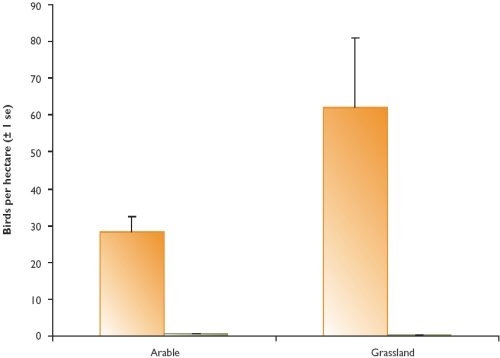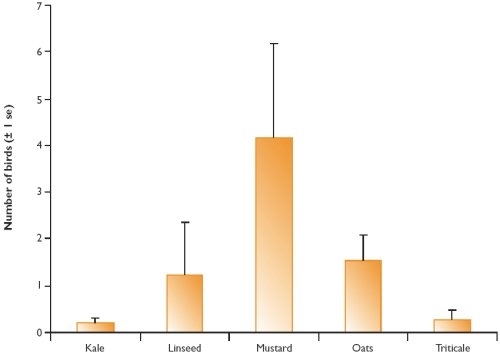Key findings
- In Scotland songbirds are more than 100 times more likely to be found in game crops than arable crops nearby.
- Songbirds are more than 340 times more likely to be found in game crops than grassland crops nearby.
- Songbirds are twice as abundant within game crops in the grassland region than within game crops in the arable region.
- Mustard and oats attract more songbirds in Scotland than other crops grown as game cover.
The decline of farmland songbirds has been well documented and the most popular hypothesis to explain this is that songbird survival rates have declined for most species, owing to a fall in the availability of food on modern farms. Our work on commonly-used game crops has shown that these can be attractive to many bird species across the country. Indeed, our work in eastern Scotland has convincingly demonstrated that up to 100 times more birds are found in game crops than other crops (see Figure 1).
However, one limitation of the research carried out to date is that it refers to arable farming systems, which are typical of much of eastern and southern Britain. This meant that for the 65% or so of agricultural land that is in one form of grassland or another, mostly concentrated in the north and west of Britain, we had no idea of the requirements of farmland songbirds, nor of the role that game crops play on these farms. To tackle this gap in our knowledge, we extended our studies of songbirds and game crops in summer 2003 into the south-west of Scotland, an area typified by intensive grassland management. We visited nine farms approximately monthly from August through to February for two winters, counting birds in game crops and nearby conventional crops. The game crops were typical of those found across Scotland (kale, triticale, mustard, maize and artichoke), with kale by far the most common (on eight of the nine farms). The conventional cropping encountered, on the other hand, was typical of that found in the region, being mostly grass silage and pasture (grazed and ungrazed), as well as some arable silage (grass mixtures sown with combinations of oats, barley and wheat).
During the course of the surveys, we saw 19 species of songbirds. We found that all of them used the game crops, but just six used the other crops. Furthermore, the songbirds we saw were on average more than 340 times as abundant in the game crops as elsewhere, with densities averaging over 60 birds per hectare (see Figure 1). This is an enormous difference - far higher than the previous work in eastern Scotland found between game and other crops, where densities in game crops averaged around 30 birds per hectare at the same time of year. This difference between farming systems is perhaps not surprising as it is highly likely that plentiful sources of seeds are far rarer in grassland areas than arable ones, so probably attract birds from a wider area than in arable regions.
Figure 1: Density of winter birds using game crops on arable and grassland areas compared with other crops

Game crops clearly attract large numbers of birds on farms across the agricultural spectrum and probably provide an important food source to them, but one of the important questions to be answered is which specific game crops should be sown? So, in spring 2003 five of the more common and easiest to grow Scottish game crops were sown in replicated blocks in five fields at two farms in Angus, to test the relative use that different species of birds may make of each type of crop. The crops grown were kale, triticale, mustard, oats and linseed. The results of bird counts since October 2003 suggest that mustard and perhaps oats attract more birds than the other crops (see Figure 2). This work complements our project to map the extent of game crops grown in Britain.
Figure 2: Songbird densities recorded on five common types of Scottish game crops in winter 2003
